
Brazil: Amazon and Salvador da Bahia,
July 2009
Welcome to the Jungle
Page 1 of 17
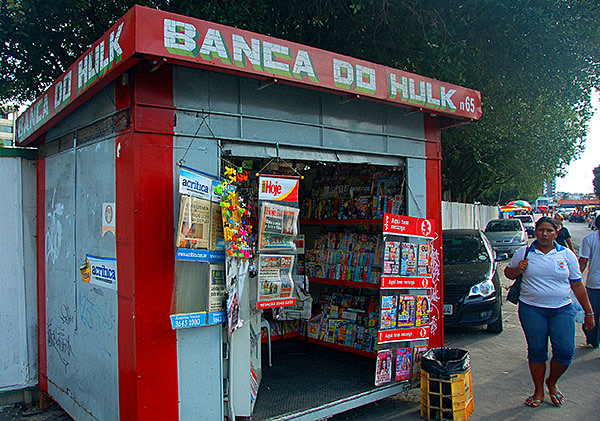 2
July Thursday - Lisa and I arrived in Manaus.
Manaus, "Mother of the Gods," situated where the Negro and Solim§es Rivers
come together, is a sweaty concrete city with 1.7 million people stuffed in
the middle of the Amazon jungle. We immediately
found our handful of lessons with the Pimsleur CDs wanting, with Spanish
coming to the rescue time and time again. 2
July Thursday - Lisa and I arrived in Manaus.
Manaus, "Mother of the Gods," situated where the Negro and Solim§es Rivers
come together, is a sweaty concrete city with 1.7 million people stuffed in
the middle of the Amazon jungle. We immediately
found our handful of lessons with the Pimsleur CDs wanting, with Spanish
coming to the rescue time and time again.~~~ Banca Do Hulk No. 65 in Manaus, the capital of Amazonia in Brazil. Beautiful that there's at least 64 more. And a good sign for a trip when you first photo is something fun like this. |
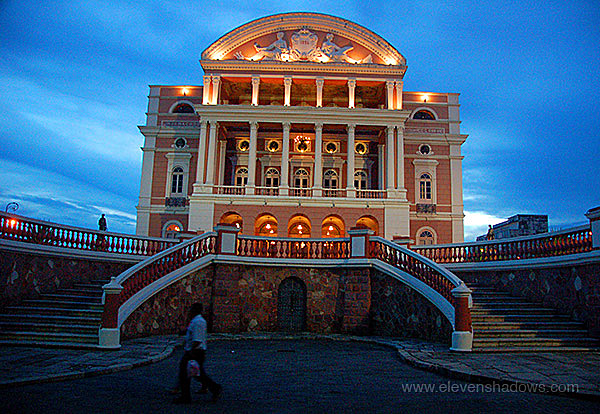 We
walked downhill towards the river from our hotel, past the Teatro Amazonas,
built in 1898, reflecting the wealth of the turn-of-the-century rubber
industry that much of Manaus was initially founded upon. We
walked downhill towards the river from our hotel, past the Teatro Amazonas,
built in 1898, reflecting the wealth of the turn-of-the-century rubber
industry that much of Manaus was initially founded upon.Eventually, we ate local fried fish, tampique, fried in olive oil and garlic, at an open-air restaurant in the shadow of the 5-star Taj Majal International Hotel. It was delicious. |
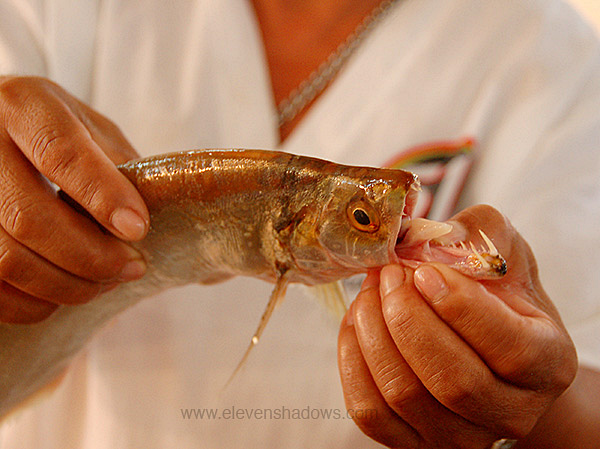 3
July Friday - Lisa and I had breakfast downstairs at our hotel.
Michael Jackson had unexpectedly passed away the week before, and
everyone was watching the public funeral on television. 3
July Friday - Lisa and I had breakfast downstairs at our hotel.
Michael Jackson had unexpectedly passed away the week before, and
everyone was watching the public funeral on television.Daniel from Maia Expeditions greeted us with his South African accent, taking us down to the fish market and the dock. We were about to start our tour of the Amazon jungle with Maia Expeditions, staying at the Dolphin Lodge 120km (75 miles) away. Mo from Maia Expeditions met us at the dock. He was our guide. But the sky opened up, releasing sheets of rain. The boat was delayed, so we took refuge at the fish market, checking out freshly caught piranhas and dogfish, shown at left. Eventually, we caught the speedboat, which stopped briefly at The Meeting of the Waters, where the Negro River's dark water and the Solim§es River's muddy brown water come together to form the Amazonas River. For several km, the waters of each river run side by side without mixing, a result of the difference in water temperatures and speed. |
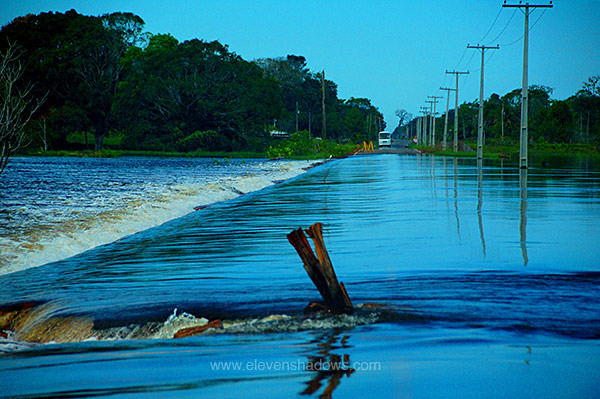 The
Amazon River is immense. It looks like an ocean. And it took us
20 minutes to cross it in a speedboat. We eventually arrived at a
small, seemingly half-submerged village. The
Amazon River is immense. It looks like an ocean. And it took us
20 minutes to cross it in a speedboat. We eventually arrived at a
small, seemingly half-submerged village.Mo went to buy ice. "For making caipirinhas," he explained. Caipirinhas are the drink of Brazil, a refreshing drink made with cachaša (ka-SHA-sah), sugar and lime. And lots of ice. Then, onward by VW van. We traversed numerous "road waterfalls" such as this. "We've had catastrophic flooding, the worst flooding since 1953," Mo explained. The Rio Negro had risen almost 30 meters (over 88 ft.). In ONE weekend. |
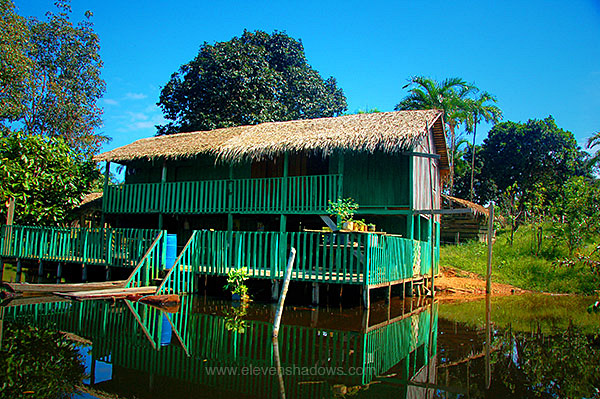 Eventually,
the VW van turned onto a dirt road, where at its terminus we climbed aboard
a smaller motorboat. We wandered through smaller tributaries, passing
Amazonian homes such as this, going deeper into the flooded jungle. We
eventually entered a larger river, the Rio Mamori, passing several flooded
homes. One was Mo's parents home, where he grew up, just two minutes
from the
Dolphin Lodge. Eventually,
the VW van turned onto a dirt road, where at its terminus we climbed aboard
a smaller motorboat. We wandered through smaller tributaries, passing
Amazonian homes such as this, going deeper into the flooded jungle. We
eventually entered a larger river, the Rio Mamori, passing several flooded
homes. One was Mo's parents home, where he grew up, just two minutes
from the
Dolphin Lodge. |
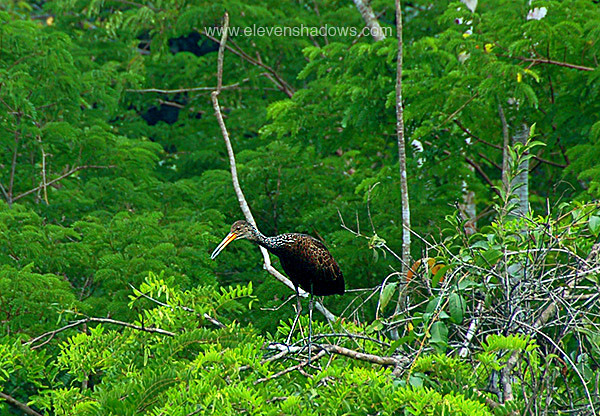 On
the way to the Dolphin Lodge, a 4 hour journey covering 120km (about 75
miles), Lisa and I were already entranced by the beauty of the Amazon around
each bend, with birds and wildlife everywhere. Mo, having grown up in
the Amazon, could spot animals quite far in the distance. On
the way to the Dolphin Lodge, a 4 hour journey covering 120km (about 75
miles), Lisa and I were already entranced by the beauty of the Amazon around
each bend, with birds and wildlife everywhere. Mo, having grown up in
the Amazon, could spot animals quite far in the distance. |
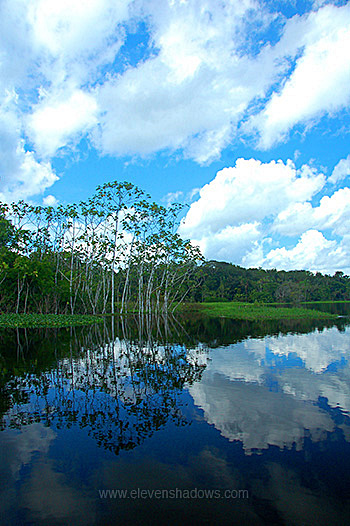 The
calm reflective waters of the flooded Amazon was hiding the jungle floor
below. We quickly realized that our boat, skimming along the waters,
was frequently 15 meters (45 ft.) above the ground, and we were seeing the
tops of many trees. The
calm reflective waters of the flooded Amazon was hiding the jungle floor
below. We quickly realized that our boat, skimming along the waters,
was frequently 15 meters (45 ft.) above the ground, and we were seeing the
tops of many trees. |
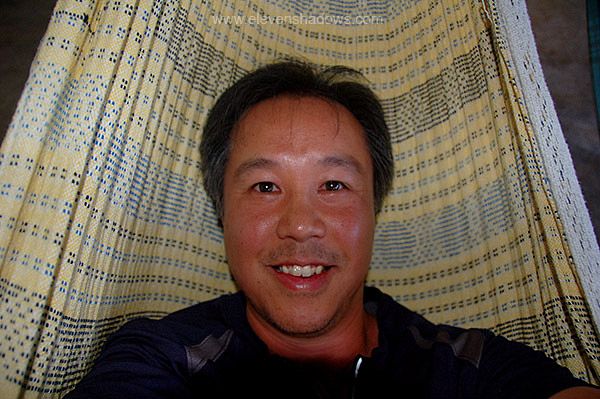 We
arrived just in time for lunch. And welcome caipirinhas. And
after several hours in the hot jungle sun, it was quite welcome. We
arrived just in time for lunch. And welcome caipirinhas. And
after several hours in the hot jungle sun, it was quite welcome.Lunch was spaghetti, rice, chicken, and salad. And manioc, flour grown from the cassava root, which grows in the Amazon...you'd sprinkle this on...well, anything you wanted to. After lunch, we laid in a hammock to read. That didn't last long. Succumbing to the heat and humidity, we promptly fell asleep. |
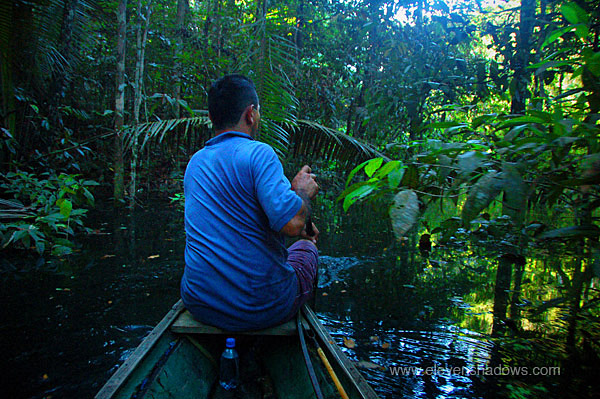 But
not for long. At 3pm, Mo took us for a ten minute walk through the
jungle to a small wooden canoe. He paddled through inky waters,
sometimes hacking his way through with his machete. But
not for long. At 3pm, Mo took us for a ten minute walk through the
jungle to a small wooden canoe. He paddled through inky waters,
sometimes hacking his way through with his machete. |
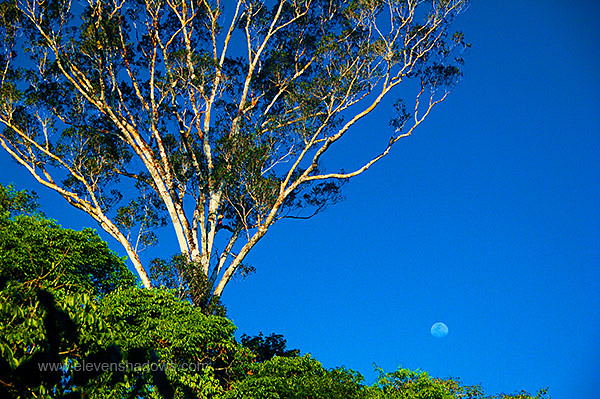 The ever-changing views were astounding. We saw three types of
monkeys, numerous birds (weaver birds, etc.), holes burrowed by armadillos,
and much more. When we came out into clearings - a lake, lagoon,
or tributary - we saw almost a full moon above the trees.
The ever-changing views were astounding. We saw three types of
monkeys, numerous birds (weaver birds, etc.), holes burrowed by armadillos,
and much more. When we came out into clearings - a lake, lagoon,
or tributary - we saw almost a full moon above the trees.
|
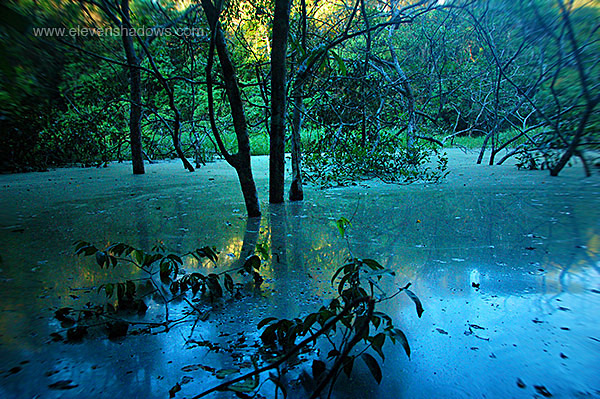 New
vistas seemed to appear with each paddle, the water changing and sometimes
taking on a milky quality. New
vistas seemed to appear with each paddle, the water changing and sometimes
taking on a milky quality. |
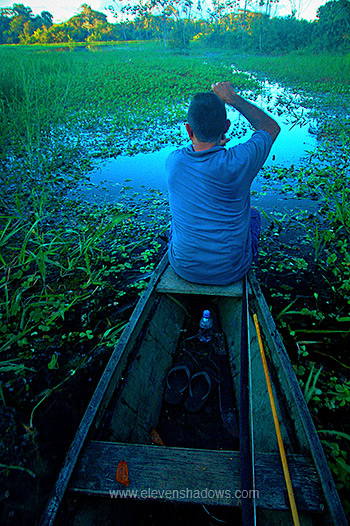 Mo
knows all the tributaries and lagoons here. He grew up only two
minutes from the
Dolphin Lodge, and greatly prefers the jungle to the big city of Manaus.
He knew all the plants and animals, all the trees, and all the people here.
Here, he was home. Mo
knows all the tributaries and lagoons here. He grew up only two
minutes from the
Dolphin Lodge, and greatly prefers the jungle to the big city of Manaus.
He knew all the plants and animals, all the trees, and all the people here.
Here, he was home.However, his wife and three children live in Manaus so they can go to school. Also, there is no high school out here in the remote jungle, only in Manaus. |
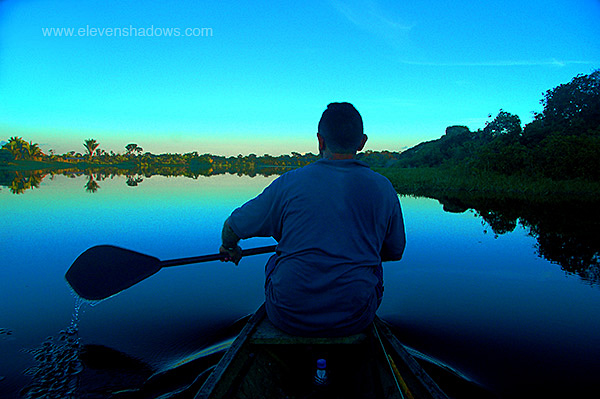 Although
the jungle is active, ever evolving, there is an indescribable serenity to
it all. I knew that, especially as city slicker, I wasn't made to
live in the jungle. But part of me wishes that I could. Although
the jungle is active, ever evolving, there is an indescribable serenity to
it all. I knew that, especially as city slicker, I wasn't made to
live in the jungle. But part of me wishes that I could. |
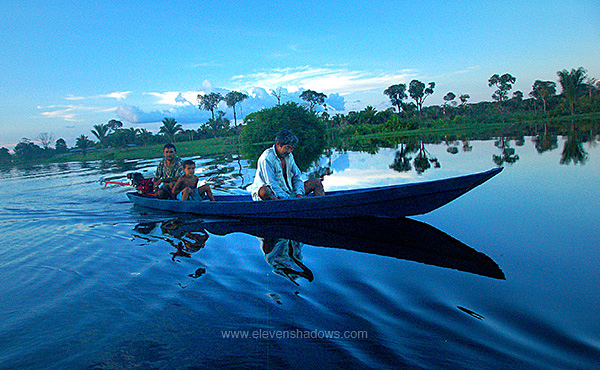 We
ran across some of Mo's relatives returning home from fishing. This is
not unusual, of course, since he grew up here. He knows everyone here. We
ran across some of Mo's relatives returning home from fishing. This is
not unusual, of course, since he grew up here. He knows everyone here.
|
Brazil: Amazon and Salvador da Bahia, July 2009
Page 1 of 17
1 2 3 4 5 6 7 8 9 10 11 12 13 14 15 16 17
EXTRA: Lisa's Photos and Videos of the Amazon
Eleven Shadows Travel Page
Contact photographer/musician Ken Lee